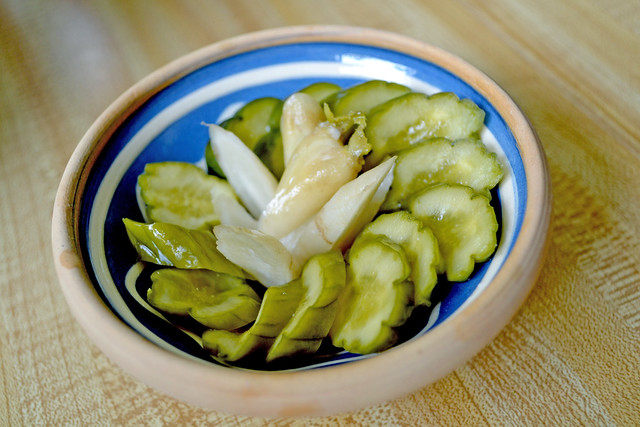
If you can get your hands on
sake kasu (sake lees, a yeast by-product of sake making) a subculture of cooking opens up to you. Most commonly used for marinating fish and pickling,
sake kasu looks like pizza dough with the consistency of wet clay and aroma of
nama (unpasteurized) sake. It's usually available for cheap, next to the
okara (tofu lees) in a Japanese or Asian market.
For my first
sake kasu challenge, I decided to make some
kasuzuke, or
sake kasu pickles.
INGREDIENTS
3 Japanese or Persian cucumbers
5 small radishes
(These are just suggestions for vegetables. Other commonly used vegetables are daikon radish, carrots and burdock root)
3 cups of
sake kasu (wet or dry)
3 tbsp of salt
1 tbsp of sugar
Splash of sake or shochu (if you are using dry
kasu)
METHOD
1. Salt vegetables liberally. Place in a plastic container and cover with saran wrap.

Leave in a dry place with a weight on it overnight.

2. The next morning, the vegetables should be limp.
3. In a mixing bowl, combine
kasu, 1 tbsp salt and 1 tbsp sugar. Mix well. If you are using dry
kasu (it will be crumbly) add a splash of sake or shochu to moisten.

4. Spread a layer of the
kasu mixture on the bottom of the plastic container.
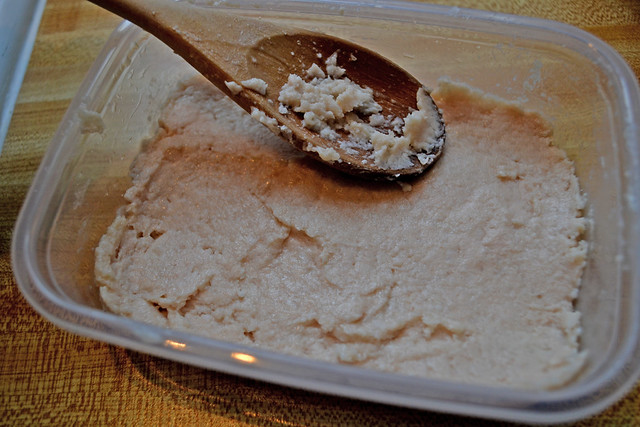
5. Add one layer of vegetables.
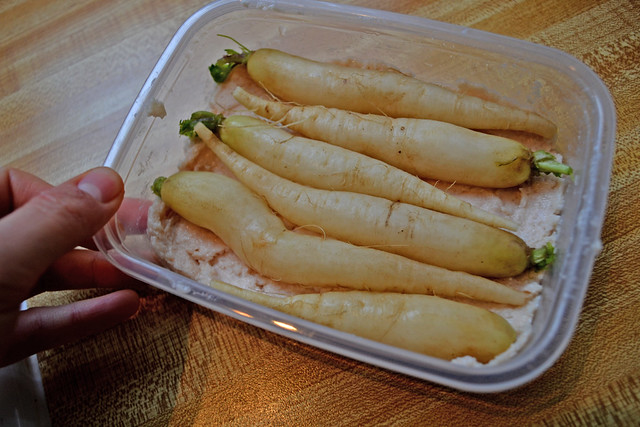
6. Spread a layer of
kasu over the first layer of vegetables.

7. Add another layer of vegetables.
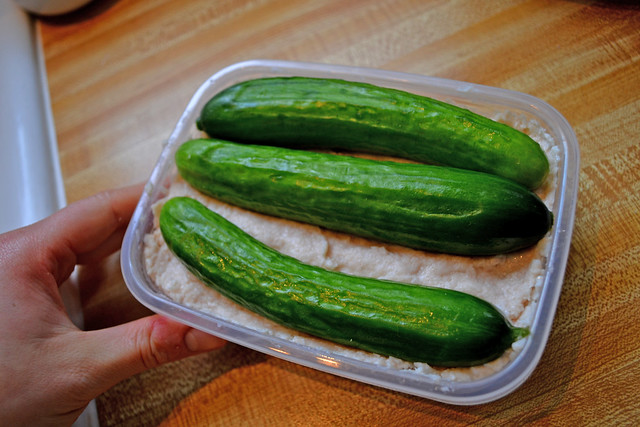
8. Spread a layer of
kasu over the second layer of vegetables.
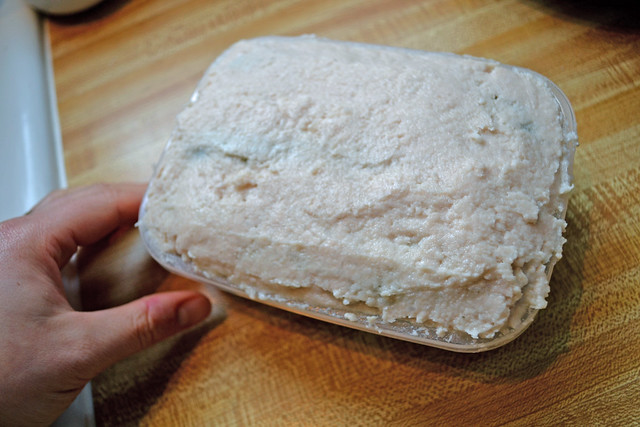
9. Cover container tightly with saran wrap and place a weight on it.
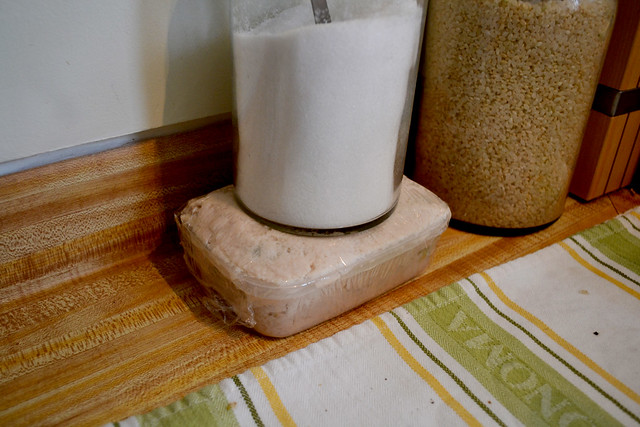
10. Wait 3-5 days.
11. Remove the vegetables from the tub and rinse the excess
kasu off in cool water.

12. Slice to enjoy. Save the rest in an air-tight plastic container (for up to 2 weeks).

The taste is sweet and mild and the smell is a little fermented (stinky in a sake kind of way). The texture is super crispy and goes really well with a hot, steaming bowl of white rice.
When root vegetables such as radishes are in season, making
kasuzuke can be an exciting way to try new varietals without having to think of specific recipes for each. Just throw them into the
sake kasu trough and wait a few days and you'll be rewarded with a crunchy, stinky (in a good way) condiment to your rice that will stay good in the fridge for up to two weeks.
Smart.
 If you can get your hands on sake kasu (sake lees, a yeast by-product of sake making) a subculture of cooking opens up to you. Most commonly used for marinating fish and pickling, sake kasu looks like pizza dough with the consistency of wet clay and aroma of nama (unpasteurized) sake. It's usually available for cheap, next to the okara (tofu lees) in a Japanese or Asian market.
For my first sake kasu challenge, I decided to make some kasuzuke, or sake kasu pickles.
INGREDIENTS
3 Japanese or Persian cucumbers
5 small radishes
(These are just suggestions for vegetables. Other commonly used vegetables are daikon radish, carrots and burdock root)
3 cups of sake kasu (wet or dry)
3 tbsp of salt
1 tbsp of sugar
Splash of sake or shochu (if you are using dry kasu)
METHOD
1. Salt vegetables liberally. Place in a plastic container and cover with saran wrap.
If you can get your hands on sake kasu (sake lees, a yeast by-product of sake making) a subculture of cooking opens up to you. Most commonly used for marinating fish and pickling, sake kasu looks like pizza dough with the consistency of wet clay and aroma of nama (unpasteurized) sake. It's usually available for cheap, next to the okara (tofu lees) in a Japanese or Asian market.
For my first sake kasu challenge, I decided to make some kasuzuke, or sake kasu pickles.
INGREDIENTS
3 Japanese or Persian cucumbers
5 small radishes
(These are just suggestions for vegetables. Other commonly used vegetables are daikon radish, carrots and burdock root)
3 cups of sake kasu (wet or dry)
3 tbsp of salt
1 tbsp of sugar
Splash of sake or shochu (if you are using dry kasu)
METHOD
1. Salt vegetables liberally. Place in a plastic container and cover with saran wrap.
 Leave in a dry place with a weight on it overnight.
Leave in a dry place with a weight on it overnight.
 2. The next morning, the vegetables should be limp.
3. In a mixing bowl, combine kasu, 1 tbsp salt and 1 tbsp sugar. Mix well. If you are using dry kasu (it will be crumbly) add a splash of sake or shochu to moisten.
2. The next morning, the vegetables should be limp.
3. In a mixing bowl, combine kasu, 1 tbsp salt and 1 tbsp sugar. Mix well. If you are using dry kasu (it will be crumbly) add a splash of sake or shochu to moisten.
 4. Spread a layer of the kasu mixture on the bottom of the plastic container.
4. Spread a layer of the kasu mixture on the bottom of the plastic container.
 5. Add one layer of vegetables.
5. Add one layer of vegetables.
 6. Spread a layer of kasu over the first layer of vegetables.
6. Spread a layer of kasu over the first layer of vegetables.
 7. Add another layer of vegetables.
7. Add another layer of vegetables.
 8. Spread a layer of kasu over the second layer of vegetables.
8. Spread a layer of kasu over the second layer of vegetables.
 9. Cover container tightly with saran wrap and place a weight on it.
9. Cover container tightly with saran wrap and place a weight on it.
 10. Wait 3-5 days.
11. Remove the vegetables from the tub and rinse the excess kasu off in cool water.
10. Wait 3-5 days.
11. Remove the vegetables from the tub and rinse the excess kasu off in cool water.
 12. Slice to enjoy. Save the rest in an air-tight plastic container (for up to 2 weeks).
12. Slice to enjoy. Save the rest in an air-tight plastic container (for up to 2 weeks).
 The taste is sweet and mild and the smell is a little fermented (stinky in a sake kind of way). The texture is super crispy and goes really well with a hot, steaming bowl of white rice.
When root vegetables such as radishes are in season, making kasuzuke can be an exciting way to try new varietals without having to think of specific recipes for each. Just throw them into the sake kasu trough and wait a few days and you'll be rewarded with a crunchy, stinky (in a good way) condiment to your rice that will stay good in the fridge for up to two weeks.
Smart.
The taste is sweet and mild and the smell is a little fermented (stinky in a sake kind of way). The texture is super crispy and goes really well with a hot, steaming bowl of white rice.
When root vegetables such as radishes are in season, making kasuzuke can be an exciting way to try new varietals without having to think of specific recipes for each. Just throw them into the sake kasu trough and wait a few days and you'll be rewarded with a crunchy, stinky (in a good way) condiment to your rice that will stay good in the fridge for up to two weeks.
Smart.




Comments (4)
I left my Kasu out for five days, has it gone bad?
Hi Yoko, just wondering while the veggies are in the kasu should the tub be refrigerated or just left on a counter? Thanks
Yoko, how many times can you use the sake kasu base? Do they last for a long time?
This is what my aunt, veteran pickler sayas
“Yes, you can use it for as long as it last. Every time you take some vegetables out from Kasu, you’ll lose some, right? So, it all depend on the frequency of using Kasu.
I just leave Gobo, Kyuri, Daikon and Ninjin in that Kasu container as long as 2 weeks to several months. It does not seem to get bad as long as you keep it refrigerated…just the flavor gets stronger."